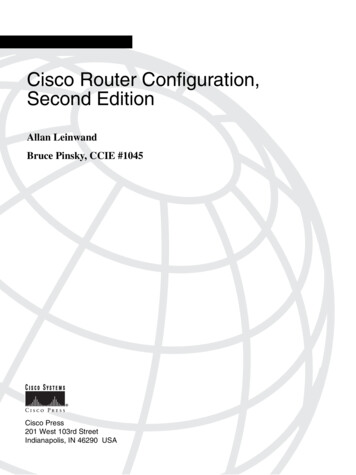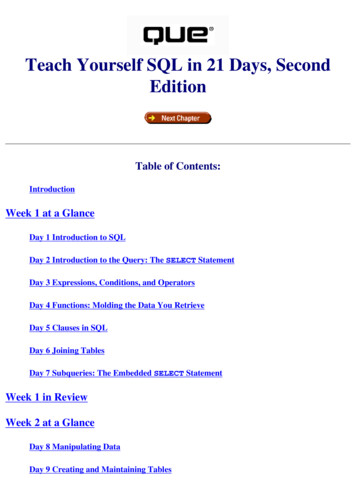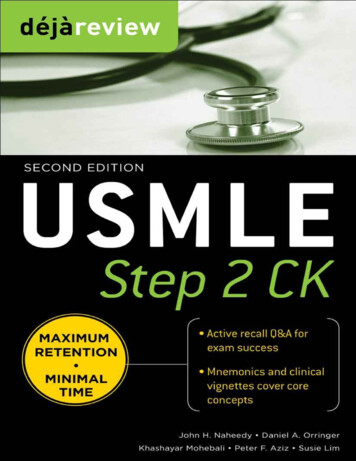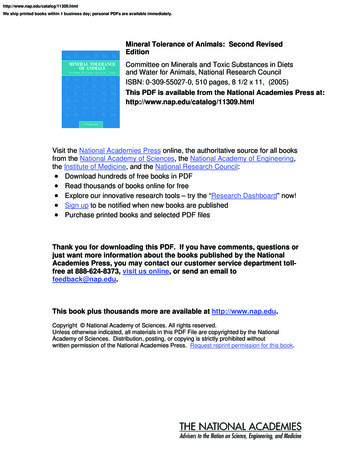
Transcription
iHealthcare ProjectManagement, Second EditionWith a Brief Guide to Microsoft ProjectProfessional 2016ByKathy SchwalbeandDan Furlong
iiHealthcare Project Management,Second EditionBack Cover Photo: Dan Schwalbe 2017 Schwalbe PublishingISBN-13: 978-1976573279ALL RIGHTS RESERVED. No part of this work covered by the copyright hereon may bereproduced, transmitted, stored, or used in any form or by any means graphic, electronic,or mechanical, including but not limited to photocopying, recording, scanning, digitizing,taping, Web distribution, information networks, or information storage and retrievalsystems, except as permitted under Section 107 or 108 of the 1976 United States CopyrightAct, without the prior written permission of the author.Materials from Kathy Schwalbe’s Information Technology Project Managementare used with permission from Cengage Learning.Microsoft and the Office logo are either registered trademarks or trademarks ofMicrosoft Corporation in the United States and/or other countries. All screenshots fromMicrosoft products are used with permission from Microsoft.Information and screenshots from MindView are used with permission fromMatchWare. Information and screenshots from Basecamp are used with permission fromBasecamp.Some of the product names and company names used in this book have been usedfor identification purposes only and may be trademarks or registered trademarks of theirrespective manufacturers and sellers.This publication is a derivative work of A Guide to the Project Management Body ofKnowledge (PMBOK Guide) – Sixth Edition, which is copyrighted material of and owned by,Project Management Institute, Inc. (PMI), Copyright 2017. This publication has beendeveloped and reproduced with the permission of PMI. Unauthorized reproduction of thismaterial is strictly prohibited. The derivative work is the copyrighted material of and ownedby, Schwalbe Publishing, Copyright 2017.PMI, PMP, CAPM, OPM3, and PMBOK are registered marks of the ProjectManagement Institute, Inc.Published by Schwalbe Publishing in Minneapolis, MN, December 2017. Visitwww. pmtexts.com or www.kathyschwalbe.com for more information on this andother books by Kathy Schwalbe.Free companion Web site: www.healthcarepm.com.
Chapter 1 – IntroductionChapter 1An Introduction to Project,Program, and PortfolioManagement in HealthcareLEARNING OBJECTIVESAfter reading this chapter, you will be able to: Understand the growing need for better project, program, and portfoliomanagement in the healthcare industry Investigate the context of healthcare projects, including a brief history ofthe U.S. healthcare industry, the nature of healthcare projects,characteristics of project team members, and recent trends in healthcarethat can affect project management Explain what a project is, provide examples of healthcare projects, listvarious attributes of projects, and describe project constraints Describe project management and discuss key elements of the projectmanagement framework, including project stakeholders, the projectmanagement knowledge areas, common tools and techniques, and projectsuccess factors Discuss the relationship between project, program, and portfoliomanagement and their contribution to enterprise success Describe the project management profession, including suggested skills forproject, program, and portfolio managers, the role of professionalorganizations like the Project Management Institute, the importance ofcertification and ethics, and the growth of project and portfoliomanagement software1
2Chapter 1 - IntroductionOPENING CASEFrancis (Fran) Anthony, the Chief Executive Officer (CEO) of America’s Best Healthcare, Inc.,was discussing strategic plans with the board of directors. “Healthcare is currently in anenvironment of change that seems to be moving at the speed of light. Health informationtechnology, policy changes, cost containment, re-admit penalties, meaningful use, evidence based medicine, and forming health networks are bearing down on us, and hard. Not to mentionour desire to improve quality measures, explore the medical home concept, improve our patientexperience, and reach rural communities. Managing a healthcare organization as it existed a fewyears ago is no longer an option, and at times it is overwhelming.”Everyone in the room took an extra breath as Fran went through the list of strategicinitiatives. One of the board members commended Fran on the success of the electronic healthrecords (EHR) implementation completed the prior year as well as the rising success of the newtelemedicine service line helping to address emergency department stroke care needs byproviding specialist access across their network. Fran responded that the “big guns” were pulledout for those projects, but several new initiatives had not gone so well.Dr. Kaheed had been on the board for the last ten years, and he understood the climatechanges Fran was talking about as well as the various levels of project success. He asked Franwhat was so different about these two major projects, particularly since similar projects seem tobe struggling at some other organizations.Fran thought for a few seconds, and then replied, “Excellent question. What has reallyhelped us the last two years is that we have embraced project management and are working tomake it a core competency. We now have a project management office staffed with professionalsto assist our organization on major projects. We assigned a full-time project manager to workwith each of those projects. Don’t get me wrong, these projects had major challenges, but wewere able to get ahead of the issues to make things work out in the end. ”Fran went on to explain that using good project management ensured that the projectshad clear goals, a good plan to follow in order to meet those goals, and a good path forintegrating the projects into the organization’s regular operations and workflow. “Boardmembers, we need to become a more project-based organization. And believe me, it will not beeasy. It’s never easy to implement changes. These skills and methodologies need to not just staywith a couple of project managers and selected projects. We need increased capability tosuccessfully manage and execute projects across the organization. We already have the talent andskills to provide quality medical care and maintain operations. If we invest what it takes to furtherdevelop the skills and talent to plan and execute projects across America’s Best Healthcare, I amvery confident that we will be able to navigate the rapid change opportunities and challenges inthe current healthcare climate and have continued success in years to come.”
Chapter 1 – Introduction3INTRODUCTIONThe opening case highlights the fact that healthcare organizations have a growing interestin project management. In the past, project management primarily focused on providingschedule and resource data to top management in just a few industries, such as the militaryand construction industries. Today’s project management involves much more, and peoplein every industry and every country manage projects. The facts below demonstrate thesignificance of project management: Demand for projects continues to increase, with GDP contributions fromproject-oriented industries forecasted to be US 20.2 trillion by 2017.Employers will need 87.7 million individuals working in project managementoriented roles by 2027, with many supporting healthcare projects. “The talentgap could result in a potential loss of some US 207.9 billion in GDP through2027.”1 Healthcare spending continues to increase. The health share of GDP isprojected to rise from 17.8 percent in 2015 to 19.9 percent by 2025. 2 Organizations waste 97 million for every 1 billion spent on projects,according to Project Management Institute’s (PMI’s) 2017 Pulse of theProfession report. That represents a 20% improvement from the previousyear. Organizations realize that excelling at project management definitelyaffects the bottom line.3 The United States (U.S.) signed The Program Management Improvement andAccountability Act (PMIAA) into law in December 2016 to enhance bestpractices in project and program management throughout the federalgovernment. In 2015, the average salary for someone in the project management professionin U.S. dollars was 108,200 per year in the U.S.; 134,000 in Switzerland, (thehighest-paid country); and 19,602 in Egypt (the lowest-paid country). Theseaverage salaries do not include bonuses. The average total compensation forproject management workers in the U.S., for example, was 130,000. Of the9,677 people from the U.S. who responded to PMI’s salary survey, 81% hadthe Project Management Professional (PMP ) credential, and their salary wasover 22% higher than those without it. This data is based on responses fromover 26,000 people in 34 countries. It is also interesting to note that 38% ofthe salary survey respondents were women, 11% had a degree in projectmanagement, and the project management department or Project ManagementOffice (PMO) was the department most listed at 31%.4Project management is also a vital skill for personal success. Managing a familybudget, planning a wedding, remodeling a house, completing a college degree,and many other personal projects can benefit from good project management.
4Chapter 1 - IntroductionWhat Went Wrong?In 2010, the American Health Information Management Association (AHIMA) worked with theAmerican Medical Informatics Association to publish “H.I.T or Miss: Lessons Learned fromHealth Information Technology Implementations”. This collection of 17 vignettes documentsreal-life situations of health IT projects that did not go well. An important lesson learned inthese tales from the trenches is the need to use sound project management principles in healthIT projects.For example, in 2015, Agnesian Healthcare, a Wisconsin-based hospital system paid 300,000 to implement Cerner’s revenue cycle software system. After installation, thehospital system noticed widespread issues with patient billing statements. Cernerdetermined these issues were fixed in 2016. By 2017, Agnesian discovered coding errors,which caused undetected write-offs. Agnesian Healthcare sued Cerner for fraud and breachof warranty. The hospital system claimed that the billing errors damaged its reputation andresulted in losses of more than 16 million. Because of the billing errors, Agnesian couldfail to meet the billing requirements mandated by the federal government. Cerner disagreedwith all of the allegations and plans to defend the case. Was this a problem with projectmanagement, such as not managing risks properly, or was it really due to vendor softwareproblems that could not have been foreseen?The Standish Group first published an often-quoted “CHAOS” study in 1995 whichreported that the overall success rate of IT application development projects in the U.S. was only16.2 percent. The researchers defined success as meeting project goals on time and on budget.The study also found that more than 31 percent of IT projects were canceled before completion,costing U.S. companies and government agencies more than 81 billion annually (1995 dollars).The authors of this study were adamant about the need for better project management in the ITindustry. They explained, “Software development projects are in chaos, and we can no longerimitate the three monkeys—hear no failures, see no failures, speak no failures.” 5In another large study, PricewaterhouseCoopers surveyed 200 companies from 30different countries about their project management maturity and found that over half of allprojects (not just IT projects) fail, including those in healthcare. They also found that only 2.5percent of corporations consistently meet their targets for scope, time, and cost goals for all typesof projects. 6Organizations claim that using project management provides advantages, such as: Better control of financial, physical, and human resources Improved customer relations Shorter development times Lower costs Higher quality and increased reliability Higher profit margins Improved productivity Better internal coordination Higher worker morale Reduced stress
Chapter 1 – Introduction5The healthcare industry has initiated and completed projects for a long time, butnot necessarily using formal project management techniques. New technologies, healthreform, evidence-based medicine, health networks, patient-centered care, medical homes,and improved patient experience are some of the many forces that are radically changingthe healthcare environment, and where there is change, there are projects! This rate ofchange, as well as increasing interest in applying business best practices from otherindustries to healthcare, has prompted the healthcare industry to examine their practices inmanaging projects. Healthcare organizations are realizing that to remain competitive, theymust develop skills to effectively select and manage the projects they undertake. They needto be conversant with and use modern project management techniques and embraceprogram and portfolio management to address enterprise-level needs.The main emphasis of this book is to help people in the healthcare industry toimprove the success rate of their projects. It does not matter whether the project is addinga new hospital wing, standing up a new specialty, preventing hospital acquired conditions,developing affiliations with other providers, starting up a patient centered medical home(PCMH), creating an accountable care organization (ACO), or advancing new technologiessuch as mobile medical devices and wearables. Healthcare projects vary in size, cost, andcomplexity, but they all share a common framework.Video HighlightsThe Yale School of Management and Change Observer created a Web site and severalvideos about the Mayo Clinic in Rochester, Minnesota, an organization known worldwidefor its excellence in healthcare and innovation. One
02.12.2017 · Accountability Act (PMIAA) into law in December 2016 to enhance best practices in project and program management throughout the federal government. In 2015, the











